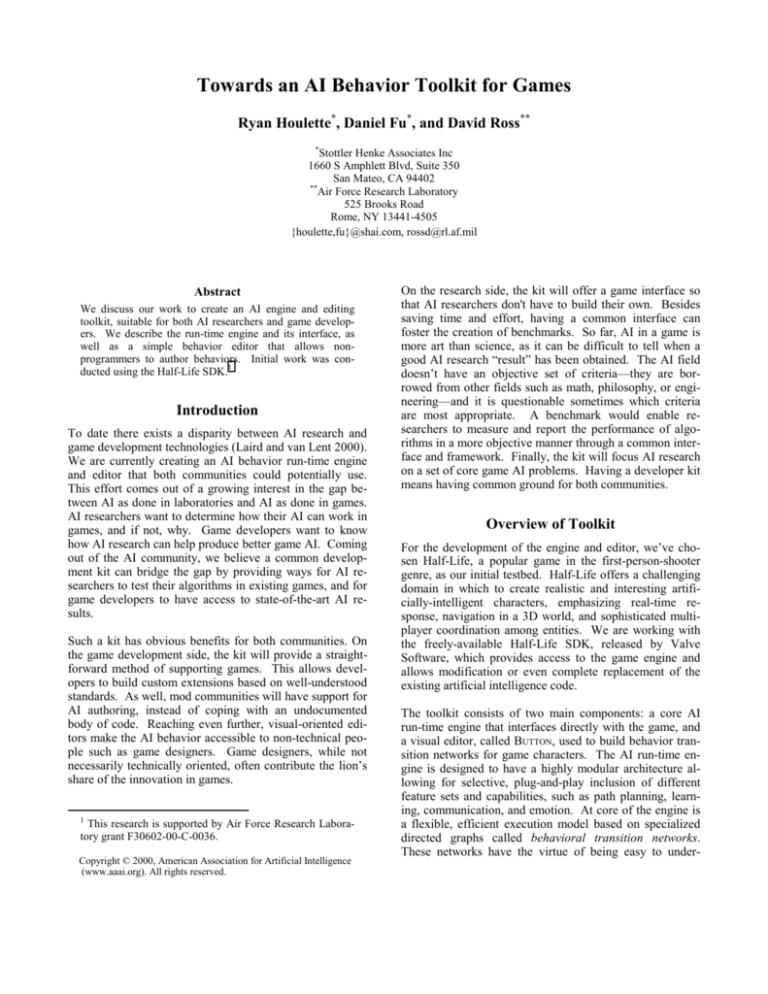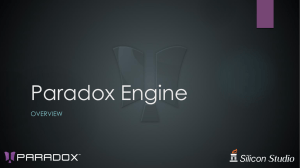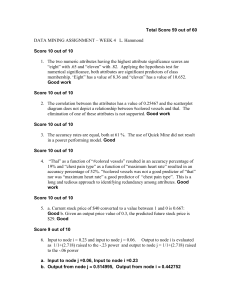
Towards an AI Behavior Toolkit for Games
Ryan Houlette*, Daniel Fu*, and David Ross**
*
Stottler Henke Associates Inc
1660 S Amphlett Blvd, Suite 350
San Mateo, CA 94402
**
Air Force Research Laboratory
525 Brooks Road
Rome, NY 13441-4505
{houlette,fu}@shai.com, rossd@rl.af.mil
Abstract
We discuss our work to create an AI engine and editing
toolkit, suitable for both AI researchers and game developers. We describe the run-time engine and its interface, as
well as a simple behavior editor that allows nonprogrammers to author behaviors. Initial work was conducted using the Half-Life SDK.1
Introduction
To date there exists a disparity between AI research and
game development technologies (Laird and van Lent 2000).
We are currently creating an AI behavior run-time engine
and editor that both communities could potentially use.
This effort comes out of a growing interest in the gap between AI as done in laboratories and AI as done in games.
AI researchers want to determine how their AI can work in
games, and if not, why. Game developers want to know
how AI research can help produce better game AI. Coming
out of the AI community, we believe a common development kit can bridge the gap by providing ways for AI researchers to test their algorithms in existing games, and for
game developers to have access to state-of-the-art AI results.
Such a kit has obvious benefits for both communities. On
the game development side, the kit will provide a straightforward method of supporting games. This allows developers to build custom extensions based on well-understood
standards. As well, mod communities will have support for
AI authoring, instead of coping with an undocumented
body of code. Reaching even further, visual-oriented editors make the AI behavior accessible to non-technical people such as game designers. Game designers, while not
necessarily technically oriented, often contribute the lion’s
share of the innovation in games.
1
This research is supported by Air Force Research Laboratory grant F30602-00-C-0036.
Copyright © 2000, American Association for Artificial Intelligence
(www.aaai.org). All rights reserved.
On the research side, the kit will offer a game interface so
that AI researchers don't have to build their own. Besides
saving time and effort, having a common interface can
foster the creation of benchmarks. So far, AI in a game is
more art than science, as it can be difficult to tell when a
good AI research “result” has been obtained. The AI field
doesn’t have an objective set of criteria—they are borrowed from other fields such as math, philosophy, or engineering—and it is questionable sometimes which criteria
are most appropriate. A benchmark would enable researchers to measure and report the performance of algorithms in a more objective manner through a common interface and framework. Finally, the kit will focus AI research
on a set of core game AI problems. Having a developer kit
means having common ground for both communities.
Overview of Toolkit
For the development of the engine and editor, we’ve chosen Half-Life, a popular game in the first-person-shooter
genre, as our initial testbed. Half-Life offers a challenging
domain in which to create realistic and interesting artificially-intelligent characters, emphasizing real-time response, navigation in a 3D world, and sophisticated multiplayer coordination among entities. We are working with
the freely-available Half-Life SDK, released by Valve
Software, which provides access to the game engine and
allows modification or even complete replacement of the
existing artificial intelligence code.
The toolkit consists of two main components: a core AI
run-time engine that interfaces directly with the game, and
a visual editor, called BUTTON, used to build behavior transition networks for game characters. The AI run-time engine is designed to have a highly modular architecture allowing for selective, plug-and-play inclusion of different
feature sets and capabilities, such as path planning, learning, communication, and emotion. At core of the engine is
a flexible, efficient execution model based on specialized
directed graphs called behavioral transition networks.
These networks have the virtue of being easy to under-
Figure 1: Screenshot of the behavior editor showing the “StrafeLeft” behavior.
stand, code, build, and test, and also boast compact code
size and fast execution.
Visual Editor
The visual editor is a stand-alone application that allows
the game developer to graphically specify the behavior of
characters in the game. The intent is to minimize the
amount of programming ability required to use the editor so
that people with non-technical backgrounds can use it with
a minimum of training to create complex and realistic behaviors. We envision the editor as a visual programming
environment, where the author can drag and drop behavior
components onto a canvas and connect them together with
various kinds of triggers, links, and conditions. Once the
author has finished editing a set of behaviors, the editor
then compiles the visual specifications into low-level binary code that can be directly executed by the run-time
engine for maximum speed.
Our prototype version of the behavior editor is based upon
an existing SHAI product called the Tactical Action Officer
Intelligent Tutoring System Scenario Generator. This
software is an authoring tool that allows the user to create
finite state machines specifying the behavior of a simulation entity. We have modified it so that we can author simple behaviors for autonomous “bots” in Half-Life. Figure 1
is a screenshot showing the editor. The author can define
behaviors by creating states and transitions in the right
pane. The editor lists all behaviors in the left pane. In this
case the left pane shows the “StrafeLeft” behavior and the
right pane shows the corresponding definition.
Run-time Architecture
In our run-time engine, each AI-directed entity associates
with one or more behaviors that dictate how it will act in
the game world. Behaviors are represented as hierarchies
of transition networks (also called behavioral transition
networks, or BTNs). These hierarchies consist of two
types of elements, transitions and nodes.
A node in a BTN represents an action that the entity may
possibly perform at some point during the game. Two
nodes in a BTN are of special significance. The current
node of a BTN denotes the action currently being carried
out by the associated entity; a given BTN may have exactly
one current node at a time per execution frame. The initial
node of a BTN is simply the node with which the BTN
begins execution (i.e., the BTN’s initial current node).
Note that the actions represented by a node may be either
concrete and primitive – for example, MoveTo(x,y,z) or
DoNothing(t) – or more abstract and complex – for example, FindNearestEnemy. An action may also represent a
deliberative or perceptual activity that has no direct physical effect on the game world. Primitive actions tend to
directly interact with the game engine through API calls,
while complex actions are generally carried out by subBTNs or specialized behavioral modules.
State U
A transition in a BTN is a directed arc connecting two
nodes X and Y (or looping from one node back to itself)
and indicating a potential direction of control flow. A decision process – typically a set of logical conditions, but
possibly something more sophisticated – is associated with
each transition. A transition is said to be active if its decision process returns a “true” result; an active transition
indicates that the BTN may change its current node from
node X to node Y.
As stated above, BTNs may be hierarchical – that is, any
node in a BTN may link to another arbitrary BTN or set of
BTNs (either enumerated explicitly or specified by a list of
descriptors). When a node with such links becomes current, execution passes to one of the linked BTNs, which
begins at its initial node. Each time this occurs, a new execution frame is put on the execution stack, which maintains
the behavioral state at each level of the currently-executing
BTN hierarchy for a given entity. This tiered structure
allows for natural decomposition of tasks and abstraction of
high-level behaviors.
At each time step during execution, the engine examines
the entity’s execution stack to determine the next transition
to be followed. Transitions are evaluated for the current
node in each execution frame, starting at the bottom of the
stack and stopping when an active transition is found. That
transition is then taken, changing the current node and
causing the associated action to be performed by the entity.
In addition, all execution frames above the one with the
active transition are popped from the stack.
Example of Execution Flow
To give an idea of how execution actually works, here is a
simple example. It refers to Figure 2, which shows the
current execution state for a single entity. The rectangles
(with rounded corners) denote nodes, and the arrows between them represent transitions. Nested nodes indicate
different levels of the hierarchy, and nodes with dashed
borders are current nodes (in their particular execution
frame).
At the current moment, the execution stack for this entity
looks like this:
Execution
Frame
Current Node
3
2
1
U
Q
L
Possible Transitions
U→V, U→W
Q→R, Q→S
L→M, L→N
Thus, when it becomes this entity’s turn in the execution
cycle, the first thing that will happen is that the action asso-
State V
State R
State Q
State W
State S
State L
State N
State M
Figure 2: Current execution state for a single entity.
ciated with node U will be called, since U is the current
node in the topmost execution frame.
Next, all viable transitions will be evaluated, starting with
the bottom of the stack and working up. Evaluating transitions in this order allows more general, ongoing actions
(i.e., higher-level plans) to take precedence over low-level,
short-term actions.
Thus, the possible transitions for execution frame #1 are
checked first:
TLM->Evaluate() == false
TLN->Evaluate() == false
Suppose that neither of these is satisfied. Evaluation now
moves to execution frame #2:
TQR->Evaluate() is true
TQS->Evaluate() is false
Note that even though TQR was determined to be satisfied,
TQS was still checked. The decision to follow a transition is
not taken until all transitions out of the current node in the
execution frame under consideration have been evaluated.
In this case, TQR is the only active transition, so there is no
choice to be made. TQR is traversed, which pops off the
now-irrelevant execution frame #3, sets the current execution frame to be #2, and sets the current node in that frame
to be R.
At the end of the execution cycle for this entity, the execution stack for this entity looks like:
Execution
Frame
2
1
Current Node
Possible Transitions
R
L
not shown
L→M, L→N
Discussion
The development of a robust, flexible, and yet comprehensible interface between the core game engine and the AI
engine is key to the creation of a useful toolkit. It is also
perhaps the most difficult component of the project. There
are two main reasons for this. First, specifying a usable
and powerful API is, in general, a hard problem, because as
the power and flexibility of the API increases, so too does
the number of abstractions and conceptual layers that must
be introduced, and this growing complexity tends to increase the learning curve and discourage new users.
Second, most AI approaches are, by their very nature,
knowledge-intensive, and the internal knowledge representations used by games – which are, almost without exception, custom solutions developed for that specific game
– vary drastically, which means that any AI toolkit hoping
to be general must be extremely versatile in order to allow
the AI component adequate access to the game information
it needs. There is a delicate balance to be struck here: if
the assumptions made by the toolkit are too broad, then the
gap between any particular game and the toolkit API will
be large, requiring an impractical amount of custom code to
be bridged. If the interface is too focused, on the other
hand, the toolkit’s applicability will be limited.
In order to combat these difficulties, we have chosen an
iterative development plan that will allow us to incrementally develop our interface and architecture, refining our
design as we learn more about the demands and necessities
involved through experimentation. As mentioned above,
our initial development has been with the Half-Life SDK;
as the project progresses, we intend to add other testbeds,
possibly including Unreal Tournament, as well as a turnbased strategy game like Civilization. The use of multiple
testbeds will help ensure that our toolkit is general enough
to be used with a variety of games.
We are currently beginning our second pass through the
development cycle, having already completed a prototype
version of both the runtime engine and the behavior editor.
We have nearly finished a revised design document based
on the lessons learned from this prototype, and we expect
to begin implementation of the first release version of the
toolkit soon.
Related Work
The notion of having a visual representation of AI behavior
is not new, both in academia and in industry. MacKenzie,
Arkin, and Cameron (1997) describe the MISSIONLAB
system that allows an author to specify the behavior of
multiple robots. The author does this visually using similar
hierarchical state and transition links.
KHOROS
(www.khoral.com) is a popular visual editor for image
processing that allows users to string together operators
into a flow diagram. Each operator comes from a standard
library, or is defined by the user using standard C code. In
industry, there are few visual editors for games. Perhaps
most notable is the Motivate package from the Motion
Factory (www.motion-factory.com). Its use is limited to
development companies and is not freely available for research use.
Conclusion
We have presented an overview of an ongoing project to
develop an AI software toolkit for computer games. The
intent of this kit is twofold: to “raise the bar” on the quality
and sophistication of AI used in games by providing powerful, easy-to-use tools for putting AI into games; and to
help legitimize game AI as a reputable branch of artificial
intelligence by providing a standard interface and framework in which researchers can implement and experiment
with their algorithms, techniques, and approaches across a
variety of game testbeds.
References
Laird, J., and van Lent, M. 2000. Human-level AI’s Killer
Application: Interactive Computer Games. In Proceedings
of the National Conference on Artificial Intelligence.
MacKenzie, D., Arkin, R.C., and Cameron, J., 1997. Multiagent Mission Specification and Execution. Autonomous
Robots, 4(1):29-57.





